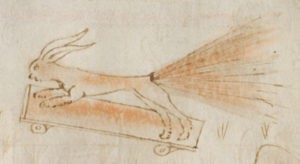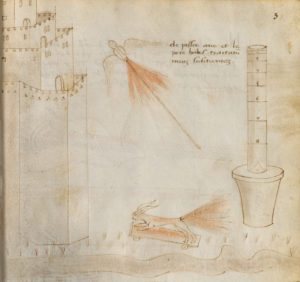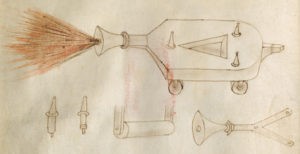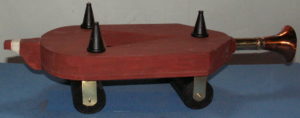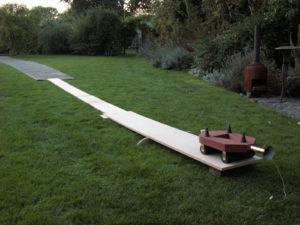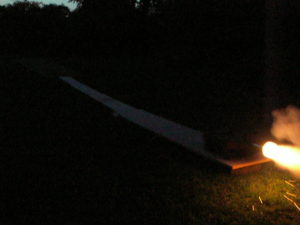Long-suffering-standing Cipher Mysteries readers cursed with photographic memories may recall a post I made back in 2008 that included images of Giovanni da Fontana’s rather wonderful Bellicorum Instrumentorum Liber. Because this is a book-sized enciphered manuscript, it is a member of a highly select club, with little more than the Voynich Manuscript and Rohonc Codex to keep it company at their Christmas dinner.
As Bert Hall put it rather nicely, though, the Bellicorum Instrumentorum Liber is not so much an illustrated text as a series of drawings accompanied by a bit of text (partially enciphered text, in this case). And the whole book is available online, which is just splendid.
Bellicorum Instrumentorum Liber
One of my favourite images from the Bellicorum Instrumentorum Liber is of what seems to be a skateboarding rabbit. By which I mean not something from Pinterest…
…but something from Bayerische Staatsbibliothek München Cod.icon. 242, fol. 37r, urn:nbn:de:bvb:12-bsb00013084-8 (“Mechanische Maschinen und Automaten”), dating to between 1420 and 1430…
If we look at the same image in context, it becomes immediately clear that this isn’t an anachronistic exercise in Internet whimsy, but a state-of-the-art early Renaissance killing machine:
This ‘rocket rabbit’, then was a quasi-terrorist device, to propel itself at speed at the foot of a building and blow itself up.
Oh, And The Rocket Cat As Well
Fontana’s rocket rabbit seems to have inspired this 1584 “rocket cat” (and similar “rocket bird”), which I saw discussed at a UPenn blog back in 2013:
The blog post also pointed to a c.1530 rocket cat:
Now Build Your Own…?
But it seems – to my eyes, at least – that even though written descriptions of “fire birds” setting besieged towns [alight] predate the Renaissance by half a millennium, it was Giovanni da Fontana’s rocket rabbit that begat the rocket cat. And what is particularly nice is that he shows us how to build one, piece by piece on Bayerische Staatsbibliothek München Cod.icon. 242, fol. 16v, urn:nbn:de:bvb:12-bsb00013084-8 (“Hydraulische Maschinen und Automaten”):
All of which, I believed, marked the end of this whole interesting line. For who on earth would be so splendidly insane as to actually build one of these for themselves? Such a person would need to have great expertise in making 3d models and historical reconstructions, and they’d need a film production company to fund it, etc etc.
That was never going to happen, was it?
Richard Windley
Step forward Richard Windley, who (it says here) “has lectured part-time in 3D Design at Hereford College of Art as well as making models and reconstructions for film and television productions”.
And step forward his awesomely wonderful rocket roller car, that was called “Fleeing tortoise” (as per the Latin description on the page) and was built for an Ancient Discoveries episode that aired on the History Channel (3×09 “Ancient Robots”? Perhaps there’s a copy on YouTube somewhere, but I haven’t yet found it):
Those who remember Zeno’s paradoxes of motion may recall that a fleeing tortoise was proved to be swifter than Achilles (to a Greek logician, anyway):
Here was Richard’s preliminary rocket car test run (in his back garden):
His car indeed went like the rocket that it was, too bright and almost too fast to capture on a normal camera:
Zeno or no Zeno, I’d like to see Achilles try to outrun that fleeing tortoise. 🙂
But my favourite photograph of the many that Richard kindly shared with me is of him in his protective “furnace suit” (though this was for a separate – and potentially lethal – Greek Fire demo for a different documentary):
If there’s a more evocative photo of an historical maker out there, I’ve yet to see it! 🙂

